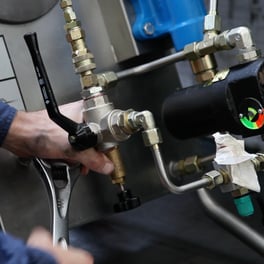In any new hydraulic system, design requirements always face off against design constraints. In a perfect world, we would be able to implement whatever solution we choose, without extraneous factors impinging on our ideas. In reality though, there are always numerous considerations that place limits on almost every aspect of any hydraulic system design.
From physical limitations to power limitations, it is always a dance between the requirements of the system and the constraints on the design. And each case is unique, because every hydraulic system must work in a particular environment, in a specific situation, often in concert with other machinery and within the confines of an existing operation.
It takes an experienced engineering team to design around these constraints to deliver on the technical requirements of the project. In this article, we’ll talk about some common constraints we encounter and give you a few things to think about, that will help you prepare your next design project for success.
5 Hydraulic System Design Constraints To Think About Before Your Next Project
What Physical Dimensions / Space Limitations Might You Encounter?

Every hydraulic system will need to fit into a physical space in the location where it is required to perform its duty. In some cases, this space can be extremely limited. For instance, deep in a mine overhead space may be lower than head height. Or, a new addition to a factory may need to fit in and around existing machinery.
Each situation is unique and in some cases, special solutions must be devised that will affect the physical dimensions of the final product. Perhaps the enclosure may need to be custom-built to a specific shape, or maybe the whole thing will need to be made more compact. Modern hydraulic engineering teams make use of computer modelling software, which enables them to accurately visualise the physical form that the system will take. These modelling programs are also valuable for identifying potential problem areas such as hydraulic hose-routing problems or to optimise the position of components such as pumps and motors for ease of access.
Electrical or Plumbing Connectivity

Another consideration is the access to utilities on-site. Again, every site is different and in remote locations issues such as access to power may influence where the unit can be located. This in turn may influence the length of pipe runs to connect the system to the machinery with which it must work. This all has an impact not only on obvious requirements such as hose length, but multiple compensations may need to be made to different parts of the system. It’s never as simple as it seems.
On-site Power Limitations
Related to the last point, you may need to consider the amount of power that may be drawn from on-site generators that must power many additional systems. In cases where power is limited, this may constrain the size of motors, pumps and other components that may be considered. This is where experience comes into play, and creative solutions may need to be devised to meet the technical requirements of the system, without coming up against power limitations.
Noise Limitations
Like all undesirable byproducts of industrial work, noise pollution is becoming less tolerable as we continue to try to improve the conditions for workers and the surrounding environment of every work site. In fact many organisations prescribe very specific limits on how much noise is acceptable. This is sometimes a challenging limitation in applications where large motors and pumps are required, and innovative solutions must be devised such as sound dampening enclosures to meet these stringent rules.
Energy Efficiency
Energy efficiency is not only an eco-friendly consideration - it is also an important driver of the long term cost of ownership of the system. So it is always wise to start with efficiency targets in mind, and to include this in the design brief as it may influence decisions such as the type of energy efficient motors, the size and number of pumps, and other variables which can influence the energy demands of the system both at idle and at peak load.
Plan Well and Prepare Your Hydraulic System Design Project for Success
As you can see, every hydraulic system is a unique engineering negotiation between design requirements and the constraints that place limitations on the decisions and ideas available. It takes not only an experienced engineering team, but often a creative one to craft a design that walks this line perfectly to deliver the optimal hydraulic system for your needs.







Leave A Comment